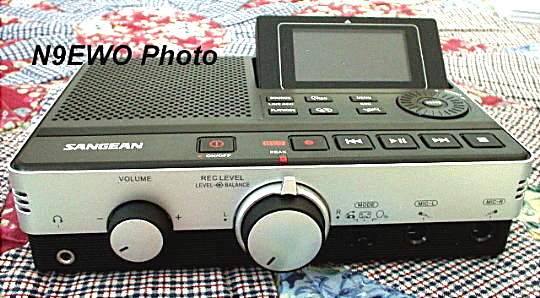|
N9EWO Review : Sangean ATS-909X2 LW / MW / SW / FM / AIR Portable Receiver |
| (as
STOCK, no modifications) |
|
*** Sangean ATS-909X2 FIRMWARE CHANGE LOG (to VER 0.78) ****
Broken English as was converted from Mandarin (PDF Format). (our thanks to "Sangean America" for this information) |
|
**** IMPORTANT NOTICE ****
*** Sangean ATS-909X2 Issues with Low LSB Audio and Drift *** Some ATS-909X2 owners are reporting these issues :
- SSB audio severely drops down (more of a drop on LSB). - Excessive drift. Our test sample does NOT suffer from either one of these ills (as tested in the review below). So these bugs appear NOT to be related to firmware (factory alignment) and is it a sample to sample issue ? This sounds like a repeat disaster of the LATER ATS-909X production samples with P01 firmware (also when hardware changes were made). Drift with our test sample was at a decent 17 hz from cold start. Again these bugs do NOT affect all samples, so please keep that in mind ! Dave N9EWO © N9EWO, all rights reserved Ver 2.3 |
| N9EWO Test - ATS-909X2 Current Consumption (approx serial no : dK2010424xx) |
| Using Included 9 VDC AC Adapter. Normal volume. (current not measured with internal batteries). Test Meter : Fluke 77 IX LCD Backlight Brightness : FULL (Backlight OFF : Deduct 25 ma from readings below). (ma = milliamperes) SW / LSB / USB : 140 ma MW : 140 ma FM : 105 ma AIR : 130 ma |
| N9EWO Test - ATS-909X2 Frequency Display Error (with approx serial no : dK2010424xx) |
| (frequencies listed below are in kHz, 1 hour warm up, room temperature) Test Frequency - 5000.00 (WWV) FIRMWARE 070 / 073 (made no difference here) LSB : 4999.70 (300 Hz LOW) USB : 4999.99 (10 Hz LOW) AM (using narrowest bandwidth setting) : 5002.0 (2.0 kHz HIGH) (NOTE : Display shows 1 kHz higher when in one of it's SSB 10/20 Hz fine tune fits with the jog wheel. But is not actually receiving 1 kHz higher. This bug was cleared up for the most part with FIRMWARE 073, see text). |
| Bottom Line : Sangean ATS-909X2 N9EWO testing - AM Mode "audio
quality" : - IF YOU normally use and prefer narrower bandwidth filters for MW/SW
AM
Mode listening then you will be very pleased with the ATS-909X2.
- IF YOU are looking (prefer) for better audio quality with wider filter(s), you should look elsewhere as in our view it is rather disappointing here. In these days of DSP bandwidth filtering we desire (more like REQUIRE) at least one wide IF filter being available in a SW receiver (8 kHz or above). MW is a tad better providing a 6 kHz widest filter setting, SW Band again falls flat on it's face at 4 kHz being the widest available with the ATS-909X2 (near unacceptable in our view). NOTE : Please remember that there is always a possibility that Sangean could change this scheme with Firmware updates down the road (or perhaps they may not) ? |

| DAR-101 with ATS-909X2 for unattended timer record. (untested and NO support here, you are on you own) |
| [Notes
: One must make a test recording prior using the proper stereo 1/8 inch
(3.5mm) STEREO patch cable between the DAR-101's LINE IN Jack and
the ATS-909X2's LINE OUT jack and adjust the REC LEVEL to a proper
approximate reading. Also if ones makes use of the VAR function (Voice
Activated Recording) with the DAR-101, it is then possible to have the
DAR-101 start and stop recording automatically
according to the input signal level. Here ONLY the MINI 1/8 inch
(3.5mm) STEREO cable is required. Another alternative would be to use the timer within the DAR-101. See the DAR-101's owners manual for
more information.]. Patch Cables Required (NOT included with the ATS-909X2 OR the DAR-101) 1 - MINI 1/8 inch (3.5mm) STEREO Phone type audio cable (both ends). 1 - MICRO 3/32 inch (2.5mm) Phone type audio cable (both ends, Stereo or Mono OK here). Step #1 Program the ATS-909X2 for ALARM TIMER operation (see pages 14~15 in the OWNERS MANUAL). Step #2 Now you must put the recorder on Standby. Turn on the recorder. Switch the mode to "Music". Press MENU. Press RECORD SETUP. Dial Record Standby. Set to ON. Step #3 Connect the cables. Turn the ATS-909X2 receiver power OFF. Turn the DAR-101 recorder power ON. First connect the MINI phone stereo cable (both ends) to the LINE IN jack on the DAR-101 recorder and LINE OUT jack on the ATS-909X2. Then connect the "Remote" cable (phone MICRO both ends) from the REMOTE (under telephone marking) jack on the DAR-101 recorder and to the STANDBY jack on the ATS-909X2. When the time arrives, the receiver will automatically receive the frequency preset and switch on the DAR-101. It will activate the recorder and the recording will begin. Step #4 After 1 HOUR (60 minutes), the radio will shut off (NOTE : OFF time in ATS-909X2 RADIO timer mode is preset and cannot be changed). The recorder will not be shut off however, but you can see it was recording. Disconnect the "Remote" cable. Set Recorder Standby to OFF. Shut off the DAR-101. |